Analys
Silver outlook to Q4 2021: A year for the hybrid metal

Nitesh Shah, Director, Research, WisdomTree, provides his 2021 outlook for silver, including the potential drivers of performance and the continued recovery of industrial demand.

“After a slow start, silver outpaced gold and most industrial metals in 2020. Initially riding gold’s defensive coattails and then getting a tailwind from its industrial traits, silver was an outperformer, gaining 47% in 2020. That compares to gold (24%), copper (27%) and nickel (21%). Silver’s hybrid status served it well in 2020 and we expect more of the same in 2021. As we articulated in Gold outlook to Q4 2021: at the crossroads of hope and fear, we start 2021 with the hope that COVID-19 vaccines will offer a route out of the malaise that the pandemic has wreaked on the health of the human population and the economies that we operate in. However, as has been abundantly clear in December 2020, the path to the recovery is likely to have many bumps along the road. Silver, playing both a defensive and cyclical role could do very well this year.
“Silver’s hybrid status has not gone unnoticed by investors. Silver held in exchange traded products (ETPs) rose to an all-time high in 2020 (Figure 1), and more remarkably at a pace never seen before. With 275mn ounces of silver added to silver exchange traded commodities in 2020, the year marks more than double the next highest year of silver ETP gains (2009 with 137mn ounces added). There was strong buying when silver was under-priced relative to gold in the first half of 2020. However, that buying slowed in the second half of the year as silver prices caught up with gold.
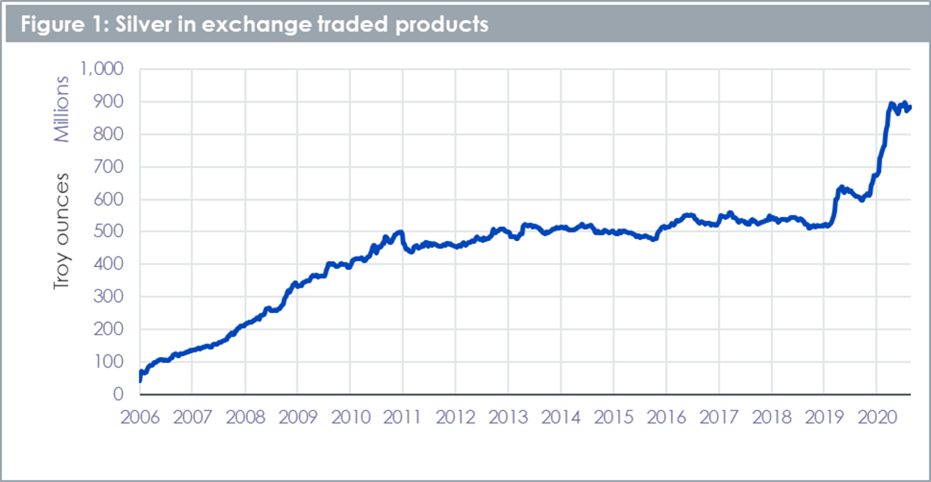
Framework
In “Gold and silver: similar, but different”, we argued that silver’s price performance is 80% correlated with gold. In our modelling framework, gold price is therefore the main driver of silver price. However, we also find the following variables as important drivers of silver price:
- Growth in manufacturing activity – more than 50% of silver’s use is in industrial applications (in contrast to gold where less than 10% comes from that sector). We use global manufacturing Purchasing Managers Index (PMI) as a proxy for industrial demand
- Growth in silver inventory – rising inventories signal greater availability of the metal and hence is price negative. We use futures market exchange inventory as a proxy
- Growth in mining capital investment (capex) – the more mines invest, the more potential supply we will see in the future. Thus, we take an 18-month lag on this variable. Given that most silver comes as a by-product of mining for other metals, we look at mining capex across the top 100 miners (not just monoline silver miners).
Gold outlook Q4 2021: at the crossroads of hope and fear
In Gold outlook to Q4 2021: at the crossroads of hope and fear we laid out our forecasts under three scenarios.
- Consensus – based on consensus forecasts for all the macroeconomic inputs and an assumption that investor sentiment towards gold remains flat at where it is today.
- Continued economic uncertainty – further monetary intervention, possibly through yield curve control – limits Treasury yields and the US dollar continues to weaken, while investor sentiment towards gold strengthens.
- Hawkish Fed – despite having adjusted its inflation target, the Federal Reserve (Fed) behaves hawkish and Treasury yields rise substantially, the US dollar appreciates back to where it was in June 2020 and inflation remains way below target. As US dollar debasement fears recede, positioning in gold futures declines.
In our silver forecast, we focus on the ‘Continued economic uncertainty scenario’ where the gold price reaches US$2130/oz at the end of the forecast horizon.
Silver forecasts
“We believe in growth terms, silver could outpace gold, reaching US$34/oz in Q4 2021 (33.6% from today’s levels, versus 13.3% for gold. We explain the other drivers to this forecast below.
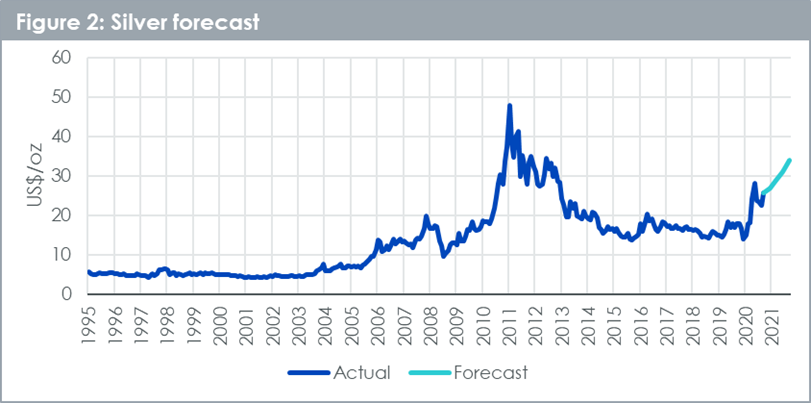
Industrial demand to continue to recover
“Manufacturing Purchasing Managers Indices (PMIs) have risen strongly in the past few months and are now in the expansionary post-50 region (Figure 3). Coming from a period of tight lockdowns, it’s unsurprising that the relative recovery from spring 2020 levels for the PMIs was strong as lockdown conditions eased. Renewed lockdowns could temporarily halt the improvement, but in general many businesses – with the support of a monetary and fiscal stimulus – will continue to see improvement. As with most historic recoveries, the pace of rebound is likely to slow in in the second half of the year. However, peaking at over 55, the PMIs indicate plenty of industrial demand for silver to be expected.
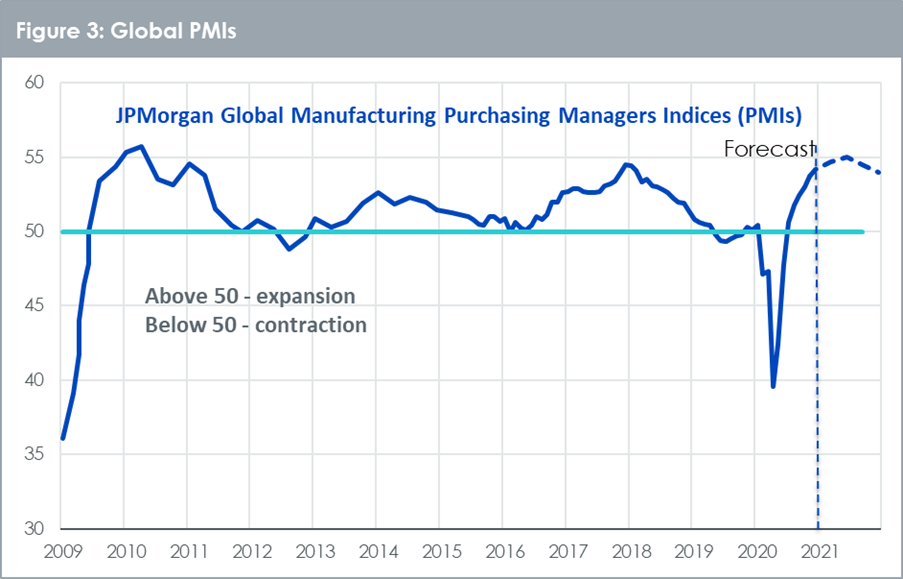
Mining supply could expand in 2021
“Our model approach uses the capital expenditure in mines as a proxy for future silver supply. While capital expenditure has declined in the past quarter (Figure 4), given the lag that we apply to this input, the rising capital expenditure we saw before that acts as a headwind for silver prices in our model approach.
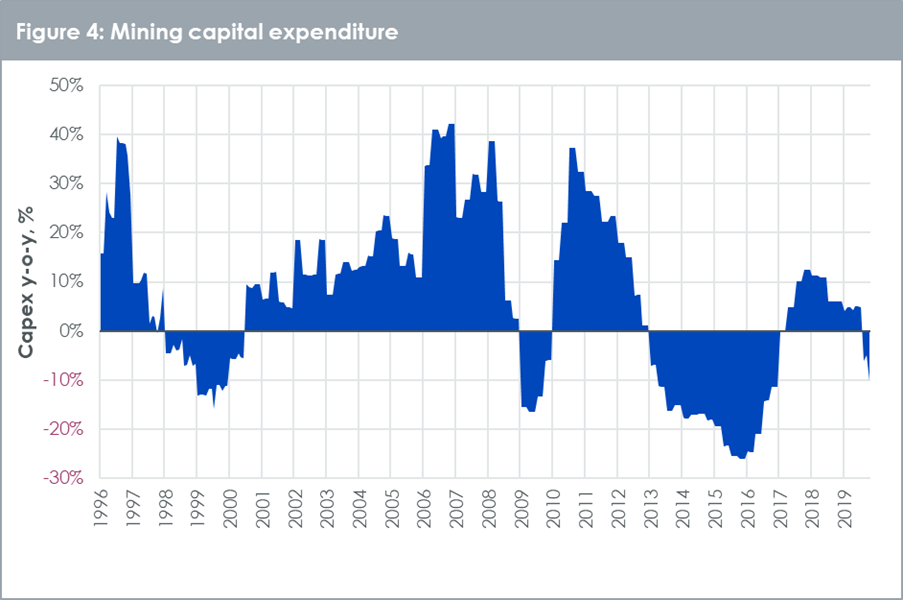
“We know that earlier in 2020 many mines were unable to operate at full capacity due to social distancing and therefore silver mine production has been lower than it would have otherwise been. Figure 5 shows how much these COVID-19 related losses were estimated to be by Metals Focus. Assuming we don’t see lockdowns reintroduced in 2021, we are very likely to see mine production of silver rebound.
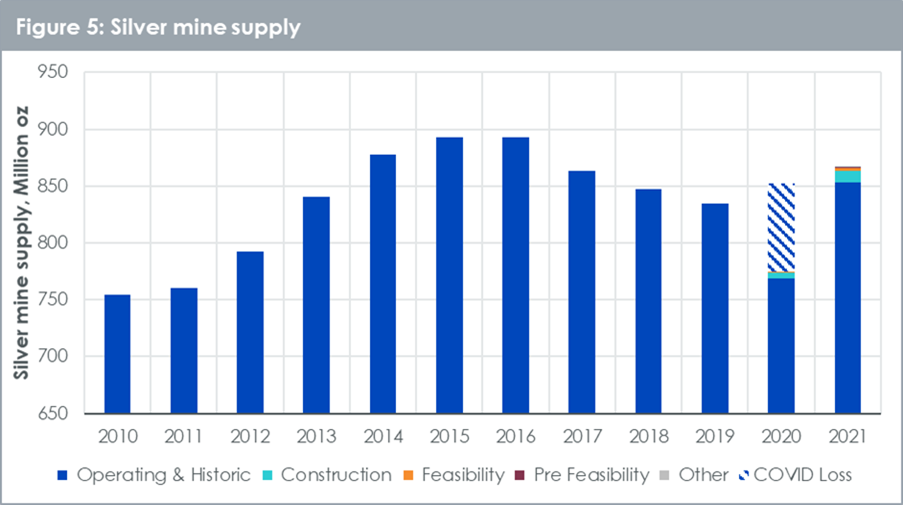
Silver exchange inventory rising again
“Silver inventory in Comex warehouses took a dip earlier in 2020 as sourcing metal became difficult under COVID-19 related operational hurdles (including flying metal from refiners in Europe, which became very difficult during lockdown). However, the supply of silver at the futures exchange was always plentiful and did not experience as sharp a dislocation from the over-the-counter spot bullion market as gold did. In recent months silver inventory on exchange has resumed its upward trajectory (Figure 6). We expect this trend to continue, adding some headwinds to silver price.
“We should note that there is a distinction between registered and eligible inventory. Eligible means the metal meets exchange’s requirements but has not been pledged as collateral against a futures market transaction. Registered means the metal meets requirements and has been pledged as collateral for futures market transactions. Eligible can easily be converted into registered, and that is why we look at the aggregate. However, most of the gains in recent years have come in the form of eligible rather than registered. That could simply be the choice of warehousing more in Comex warehouses rather than other warehouses. Nevertheless, the greater source of visible inventory has had a price dampening impact on silver. We expect rising inventory to continue to have this effect in the future.
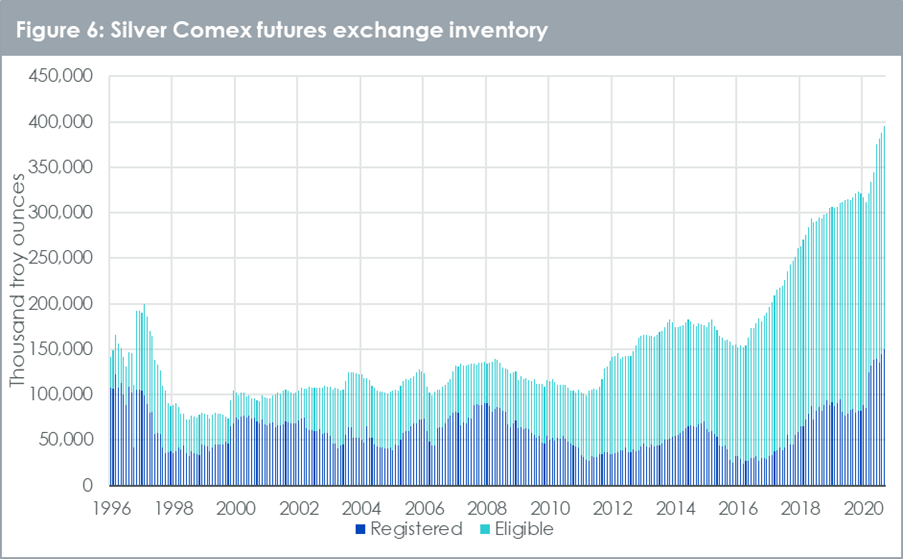
Silver is not as cheap as it was in 2020
“After spiking to a modern-era high in Q1 2020, the gold-to-silver ratio is now sitting only slightly above its historic average since 1990 (Figure 7). In this regard silver is not as ‘cheap’ as it was in Q1 2020. We still expect silver outperformance over gold this year however, and our current forecasts (under the ‘continued economic uncertainty’ scenario) would put the gold-to-silver ratio at 63 at the end of 2021, just below the historic average of 68.
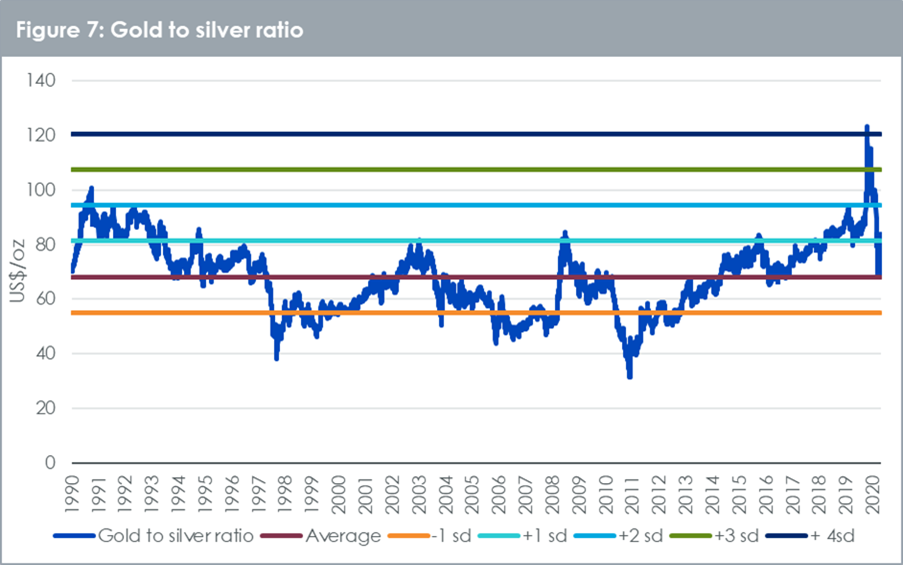
Conclusion
“Although silver faces some headwinds from potential supply increases, its correlation to gold should act as strong tailwind. Moreover, its hybrid status will allow it to benefit from a cyclical upswing, as we pass the ‘bumps in the road’ in combating the COVID-19 pandemic. Silver has outperformed gold in 2020 and its historic high gold-beta may continue to see it outperform gold when gold is rising.”
Nitesh Shah, Director, Research, WisdomTree
Analys
Tightening fundamentals – bullish inventories from DOE

The latest weekly report from the US DOE showed a substantial drawdown across key petroleum categories, adding more upside potential to the fundamental picture.

Commercial crude inventories (excl. SPR) fell by 5.8 million barrels, bringing total inventories down to 415.1 million barrels. Now sitting 11% below the five-year seasonal norm and placed in the lowest 2015-2022 range (see picture below).
Product inventories also tightened further last week. Gasoline inventories declined by 2.1 million barrels, with reductions seen in both finished gasoline and blending components. Current gasoline levels are about 3% below the five-year average for this time of year.
Among products, the most notable move came in diesel, where inventories dropped by almost 4.1 million barrels, deepening the deficit to around 20% below seasonal norms – continuing to underscore the persistent supply tightness in diesel markets.
The only area of inventory growth was in propane/propylene, which posted a significant 5.1-million-barrel build and now stands 9% above the five-year average.
Total commercial petroleum inventories (crude plus refined products) declined by 4.2 million barrels on the week, reinforcing the overall tightening of US crude and products.


Analys
Bombs to ”ceasefire” in hours – Brent below $70

A classic case of “buy the rumor, sell the news” played out in oil markets, as Brent crude has dropped sharply – down nearly USD 10 per barrel since yesterday evening – following Iran’s retaliatory strike on a U.S. air base in Qatar. The immediate reaction was: “That was it?” The strike followed a carefully calibrated, non-escalatory playbook, avoiding direct threats to energy infrastructure or disruption of shipping through the Strait of Hormuz – thus calming worst-case fears.

After Monday morning’s sharp spike to USD 81.4 per barrel, triggered by the U.S. bombing of Iranian nuclear facilities, oil prices drifted sideways in anticipation of a potential Iranian response. That response came with advance warning and caused limited physical damage. Early this morning, both the U.S. President and Iranian state media announced a ceasefire, effectively placing a lid on the immediate conflict risk – at least for now.
As a result, Brent crude has now fallen by a total of USD 12 from Monday’s peak, currently trading around USD 69 per barrel.
Looking beyond geopolitics, the market will now shift its focus to the upcoming OPEC+ meeting in early July. Saudi Arabia’s decision to increase output earlier this year – despite falling prices – has drawn renewed attention considering recent developments. Some suggest this was a response to U.S. pressure to offset potential Iranian supply losses.
However, consensus is that the move was driven more by internal OPEC+ dynamics. After years of curbing production to support prices, Riyadh had grown frustrated with quota-busting by several members (notably Kazakhstan). With Saudi Arabia cutting up to 2 million barrels per day – roughly 2% of global supply – returns were diminishing, and the risk of losing market share was rising. The production increase is widely seen as an effort to reassert leadership and restore discipline within the group.
That said, the FT recently stated that, the Saudis remain wary of past missteps. In 2018, Riyadh ramped up output at Trump’s request ahead of Iran sanctions, only to see prices collapse when the U.S. granted broad waivers – triggering oversupply. Officials have reportedly made it clear they don’t intend to repeat that mistake.
The recent visit by President Trump to Saudi Arabia, which included agreements on AI, defense, and nuclear cooperation, suggests a broader strategic alignment. This has fueled speculation about a quiet “pump-for-politics” deal behind recent production moves.
Looking ahead, oil prices have now retraced the entire rally sparked by the June 13 Israel–Iran escalation. This retreat provides more political and policy space for both the U.S. and Saudi Arabia. Specifically, it makes it easier for Riyadh to scale back its three recent production hikes of 411,000 barrels each, potentially returning to more moderate increases of 137,000 barrels for August and September.
In short: with no major loss of Iranian supply to the market, OPEC+ – led by Saudi Arabia – no longer needs to compensate for a disruption that hasn’t materialized, especially not to please the U.S. at the cost of its own market strategy. As the Saudis themselves have signaled, they are unlikely to repeat previous mistakes.
Conclusion: With Brent now in the high USD 60s, buying oil looks fundamentally justified. The geopolitical premium has deflated, but tensions between Israel and Iran remain unresolved – and the risk of missteps and renewed escalation still lingers. In fact, even this morning, reports have emerged of renewed missile fire despite the declared “truce.” The path forward may be calmer – but it is far from stable.
Analys
A muted price reaction. Market looks relaxed, but it is still on edge waiting for what Iran will do

Brent crossed the 80-line this morning but quickly fell back assigning limited probability for Iran choosing to close the Strait of Hormuz. Brent traded in a range of USD 70.56 – 79.04/b last week as the market fluctuated between ”Iran wants a deal” and ”US is about to attack Iran”. At the end of the week though, Donald Trump managed to convince markets (and probably also Iran) that he would make a decision within two weeks. I.e. no imminent attack. Previously when when he has talked about ”making a decision within two weeks” he has often ended up doing nothing in the end. The oil market relaxed as a result and the week ended at USD 77.01/b which is just USD 6/b above the year to date average of USD 71/b.

Brent jumped to USD 81.4/b this morning, the highest since mid-January, but then quickly fell back to a current price of USD 78.2/b which is only up 1.5% versus the close on Friday. As such the market is pricing a fairly low probability that Iran will actually close the Strait of Hormuz. Probably because it will hurt Iranian oil exports as well as the global oil market.
It was however all smoke and mirrors. Deception. The US attacked Iran on Saturday. The attack involved 125 warplanes, submarines and surface warships and 14 bunker buster bombs were dropped on Iranian nuclear sites including Fordow, Natanz and Isfahan. In response the Iranian Parliament voted in support of closing the Strait of Hormuz where some 17 mb of crude and products is transported to the global market every day plus significant volumes of LNG. This is however merely an advise to the Supreme leader Ayatollah Ali Khamenei and the Supreme National Security Council which sits with the final and actual decision.
No supply of oil is lost yet. It is about the risk of Iran closing the Strait of Hormuz or not. So far not a single drop of oil supply has been lost to the global market. The price at the moment is all about the assessed risk of loss of supply. Will Iran choose to choke of the Strait of Hormuz or not? That is the big question. It would be painful for US consumers, for Donald Trump’s voter base, for the global economy but also for Iran and its population which relies on oil exports and income from selling oil out of that Strait as well. As such it is not a no-brainer choice for Iran to close the Strait for oil exports. And looking at the il price this morning it is clear that the oil market doesn’t assign a very high probability of it happening. It is however probably well within the capability of Iran to close the Strait off with rockets, mines, air-drones and possibly sea-drones. Just look at how Ukraine has been able to control and damage the Russian Black Sea fleet.
What to do about the highly enriched uranium which has gone missing? While the US and Israel can celebrate their destruction of Iranian nuclear facilities they are also scratching their heads over what to do with the lost Iranian nuclear material. Iran had 408 kg of highly enriched uranium (IAEA). Almost weapons grade. Enough for some 10 nuclear warheads. It seems to have been transported out of Fordow before the attack this weekend.
The market is still on edge. USD 80-something/b seems sensible while we wait. The oil market reaction to this weekend’s events is very muted so far. The market is still on edge awaiting what Iran will do. Because Iran will do something. But what and when? An oil price of 80-something seems like a sensible level until something do happen.
-

 Nyheter3 veckor sedan
Nyheter3 veckor sedanStor uppsida i Lappland Guldprospekterings aktie enligt analys
-

 Nyheter4 veckor sedan
Nyheter4 veckor sedanBrookfield ska bygga ett AI-datacenter på hela 750 MW i Strängnäs
-

 Nyheter3 veckor sedan
Nyheter3 veckor sedanSilverpriset släpar efter guldets utveckling, har mer uppsida
-

 Nyheter4 veckor sedan
Nyheter4 veckor sedanTradingfirman XTX Markets bygger datacenter i finska Kajana för 1 miljard euro
-

 Nyheter2 veckor sedan
Nyheter2 veckor sedanUppgången i oljepriset planade ut under helgen
-

 Nyheter2 veckor sedan
Nyheter2 veckor sedanLåga elpriser i sommar – men mellersta Sverige får en ökning
-

 Analys2 veckor sedan
Analys2 veckor sedanVery relaxed at USD 75/b. Risk barometer will likely fluctuate to higher levels with Brent into the 80ies or higher coming 2-3 weeks
-

 Nyheter1 vecka sedan
Nyheter1 vecka sedanMahvie Minerals växlar spår – satsar fullt ut på guld

















